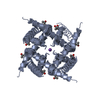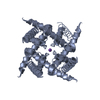+ Open data
Open data
- Basic information
Basic information
| Entry | Database: PDB / ID: 4pdv | ||||||||||||
|---|---|---|---|---|---|---|---|---|---|---|---|---|---|
| Title | Structure of K+ selective NaK mutant in barium and potassium | ||||||||||||
 Components Components | Potassium channel protein | ||||||||||||
 Keywords Keywords |  TRANSPORT PROTEIN / TRANSPORT PROTEIN /  Bacillus cereus / Bacillus cereus /  Binding Sites / Binding Sites /  Electrophysiology / Electrophysiology /  Ions / Ions /  Potassium / Potassium /  Potassium Channels / Potassium Channels /  Sodium / Sodium /  barium / barium /  blockage blockage | ||||||||||||
| Function / homology |  Function and homology information Function and homology informationstabilization of membrane potential / potassium ion leak channel activity / outward rectifier potassium channel activity /  membrane / identical protein binding / membrane / identical protein binding /  metal ion binding metal ion bindingSimilarity search - Function | ||||||||||||
| Biological species |   Bacillus cereus (bacteria) Bacillus cereus (bacteria) | ||||||||||||
| Method |  X-RAY DIFFRACTION / X-RAY DIFFRACTION /  SYNCHROTRON / SYNCHROTRON /  MOLECULAR REPLACEMENT / Resolution: 1.821 Å MOLECULAR REPLACEMENT / Resolution: 1.821 Å | ||||||||||||
 Authors Authors | Lam, Y. / Zeng, W. / Sauer, D.B. / Jiang, Y. | ||||||||||||
| Funding support |  United States, 3items United States, 3items
| ||||||||||||
 Citation Citation |  Journal: To Be Published Journal: To Be PublishedTitle: High Resolution Structural Views of Rubidium, Cesium and Barium Binding within a Potassium Selective Channel Filter Authors: Lam, Y. / Zeng, W. / Sauer, D.B. / Jiang, Y. | ||||||||||||
| History |
|
- Structure visualization
Structure visualization
| Structure viewer | Molecule:  Molmil Molmil Jmol/JSmol Jmol/JSmol |
|---|
- Downloads & links
Downloads & links
- Download
Download
| PDBx/mmCIF format |  4pdv.cif.gz 4pdv.cif.gz | 89 KB | Display |  PDBx/mmCIF format PDBx/mmCIF format |
|---|---|---|---|---|
| PDB format |  pdb4pdv.ent.gz pdb4pdv.ent.gz | 67.7 KB | Display |  PDB format PDB format |
| PDBx/mmJSON format |  4pdv.json.gz 4pdv.json.gz | Tree view |  PDBx/mmJSON format PDBx/mmJSON format | |
| Others |  Other downloads Other downloads |
-Validation report
| Arichive directory |  https://data.pdbj.org/pub/pdb/validation_reports/pd/4pdv https://data.pdbj.org/pub/pdb/validation_reports/pd/4pdv ftp://data.pdbj.org/pub/pdb/validation_reports/pd/4pdv ftp://data.pdbj.org/pub/pdb/validation_reports/pd/4pdv | HTTPS FTP |
|---|
-Related structure data
| Related structure data |  4pdlC  4pdmC  4pdrC  3oufS C: citing same article ( S: Starting model for refinement |
|---|---|
| Similar structure data |
- Links
Links
- Assembly
Assembly
| Deposited unit | 
| ||||||||||||||||||||||||||||||||||||
|---|---|---|---|---|---|---|---|---|---|---|---|---|---|---|---|---|---|---|---|---|---|---|---|---|---|---|---|---|---|---|---|---|---|---|---|---|---|
| 1 | 
| ||||||||||||||||||||||||||||||||||||
| 2 | 
| ||||||||||||||||||||||||||||||||||||
| Unit cell |
| ||||||||||||||||||||||||||||||||||||
| Components on special symmetry positions |
|
- Components
Components
| #1: Protein |  Mass: 10771.673 Da / Num. of mol.: 2 / Fragment: UNP residues 20-110 / Mutation: D66Y, N68D Source method: isolated from a genetically manipulated source Source: (gene. exp.)   Bacillus cereus (bacteria) / Strain: ATCC 14579 / DSM 31 / Gene: BC_0669 / Plasmid: pQE60 / Production host: Bacillus cereus (bacteria) / Strain: ATCC 14579 / DSM 31 / Gene: BC_0669 / Plasmid: pQE60 / Production host:   Escherichia coli (E. coli) / Strain (production host): SG13009 / References: UniProt: Q81HW2 Escherichia coli (E. coli) / Strain (production host): SG13009 / References: UniProt: Q81HW2#2: Chemical | ChemComp-K / #3: Chemical | #4: Chemical | ChemComp-MPD / (  2-Methyl-2,4-pentanediol 2-Methyl-2,4-pentanediol#5: Water | ChemComp-HOH / |  Water Water |
|---|
-Experimental details
-Experiment
| Experiment | Method:  X-RAY DIFFRACTION / Number of used crystals: 1 X-RAY DIFFRACTION / Number of used crystals: 1 |
|---|
- Sample preparation
Sample preparation
| Crystal | Density Matthews: 2.41 Å3/Da / Density % sol: 48.94 % |
|---|---|
Crystal grow | Temperature: 293 K / Method: vapor diffusion, sitting drop / pH: 6 Details: 65%MPD, 100mM KCl, 100mM MES, 4mM n-Decyl-beta-D-Maltoside PH range: 6.0-7.5 |
-Data collection
| Diffraction | Mean temperature: 78 K |
|---|---|
| Diffraction source | Source:  SYNCHROTRON / Site: SYNCHROTRON / Site:  ALS ALS  / Beamline: 8.2.2 / Wavelength: 0.9793 Å / Beamline: 8.2.2 / Wavelength: 0.9793 Å |
| Detector | Type: ADSC QUANTUM 315 / Detector: CCD / Date: Jun 9, 2009 |
| Radiation | Protocol: SINGLE WAVELENGTH / Monochromatic (M) / Laue (L): M / Scattering type: x-ray |
| Radiation wavelength | Wavelength : 0.9793 Å / Relative weight: 1 : 0.9793 Å / Relative weight: 1 |
| Reflection | Resolution: 1.821→50 Å / Num. obs: 128478 / % possible obs: 99.53 % / Redundancy: 7.1 % / Net I/σ(I): 37 |
| Reflection shell | Redundancy: 7.2 % / % possible all: 100 |
- Processing
Processing
| Software | Name: PHENIX / Version: (phenix.refine: 1.8.4_1496) / Classification: refinement | ||||||||||||||||||||||||||||||||||||||||||||||||||||||||
|---|---|---|---|---|---|---|---|---|---|---|---|---|---|---|---|---|---|---|---|---|---|---|---|---|---|---|---|---|---|---|---|---|---|---|---|---|---|---|---|---|---|---|---|---|---|---|---|---|---|---|---|---|---|---|---|---|---|
| Refinement | Method to determine structure : :  MOLECULAR REPLACEMENT MOLECULAR REPLACEMENTStarting model: 3OUF Resolution: 1.821→32.795 Å / SU ML: 0.2 / Cross valid method: FREE R-VALUE / σ(F): 1.37 / Phase error: 25.46 / Stereochemistry target values: ML
| ||||||||||||||||||||||||||||||||||||||||||||||||||||||||
| Solvent computation | Shrinkage radii: 0.9 Å / VDW probe radii: 1.11 Å / Solvent model: FLAT BULK SOLVENT MODEL | ||||||||||||||||||||||||||||||||||||||||||||||||||||||||
| Refinement step | Cycle: LAST / Resolution: 1.821→32.795 Å
| ||||||||||||||||||||||||||||||||||||||||||||||||||||||||
| Refine LS restraints |
| ||||||||||||||||||||||||||||||||||||||||||||||||||||||||
| LS refinement shell |
|
 Movie
Movie Controller
Controller













 PDBj
PDBj








